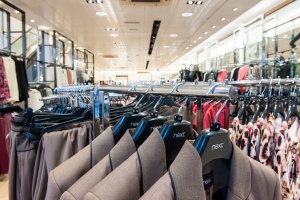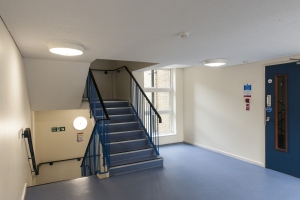The LED refurbishment revolution

In just a few short years LED lighting has transformed the potential for refurbishment projects. Martyn Wherry gives a manufacturer’s perspective.
Who would ever have thought that a business like Luxonic had to completely ‘re-write itself’ over a period of just three to four years because of the onslaught of LEDs as a serious light source? In 27 years we have never seen such a change in the lighting industry as we have within this period. Whilst most of us have lost sleep during this time, the advantages that this technical development has brought to our industry are now almost difficult to believe.
One of the key sectors to benefit from the LED revolution is the refurbishment of premises all over the UK. What started off some four years ago with LEDs as a potential consideration for the likes of dingy warehouses where 400 W SON spun-aluminium high-bay luminaires were seen as a possible win scenario in terms of energy savings and difficult access maintenance has turned into 95% of our sales being LED based.
Never has a change happened so quickly in our industry.
Now we are in the position where lighting schemes with fluorescent-based luminaires with efficiencies of 75%-plus are seen to be ‘old hat’, and some form of LED-based replacement is now available— saving energy and reducing maintenance. Refurbishments of both fashion and food retailers is rife, along with the last bastion of lit spaces that couldn’t possibly move to have LEDs as a light source! — the commercial office environment.
 |
| Luxonic LED luminaires have been used in the refurbishment programme of Next stores to achieve an overall 40% energy saving. |
So fast and so effective has this change been that major property developers are now writing very detailed luminaire and environment specifications to ensure that the quality of the product that gets specified and supplied to their projects is controlled and will actually deliver the commonly claimed attributes of good colour rendering, long life and energy savings.
From my company’s point of view, all this confusion in a swamped market is good. As a technically based business that understands light, we are as keen as all our major competitors to differentiate ourselves from the lesser-quality entrants to this market to ensure that both as a business and also as a UK industry, we deliver what we have told our customers we will. Nothing ruins a reputation more quickly than promising 50% energy savings and only delivering 20%, whilst heaping problems of poor quality LEDs, drivers and products onto an unsuspecting market that was only too willing to benefit from the original claims.
At Luxonic we work with customers in different market sectors to refurbish lighting schemes with LED solutions — industrial with the warehouse and 400 W high-bay fittings, food retailers with the twin 58 W T8 trough lighting that is endemic in this industry; ceramic metal-halide lamps in the fashion retailing sector; and all manner of modular fluorescent luminaires in the many office installations around the country.
There are many good solutions for these environments that adopt excellent luminaire design policies, some which have been around for many years. They include controlled distribution, high-efficiency outputs, good-quality gear with minimal losses and excellent thermal management within the luminaire to ensure the product’s life and general expectations are achieved.
 |
| Over 350 Luxonic wall- and ceiling-mounted Corrilux LED luminaires have been installed throughout the circulation areas;, stairwells, corridor and communal spaces of Dinwiddy House, a University of London hall of residence. |
Indeed some warehouse LED lighting schemes have seen as much as 85% energy savings by introducing all these measures — including the all-important good lighting controls. For example dimming controls and integrated presence detectors allow light levels to dim to 10% of the maximum output when an area is vacated, and hand-held remotes enable individual luminaires to be programmed and controlled.
Of course the advent of LEDs has given the luminaire and controls designer and manufacturer a hugely steep learning curve — but one that we have enjoyed and found challenging in equal measure
The results now are evident. Our customer base is growing. Our results speak for themselves. So much credit should go to the UK lighting industry which has worked so hard to harness the new technology for a myriad of applications.
We are good at what we do, so let us continue to achieve the energy savings that we have proved can be delivered and light space well. We all benefit from this, not least the UK public who live and work in more pleasant and efficient spaces.
Martyn Wherry is regional director with Luxonic Lighting.








